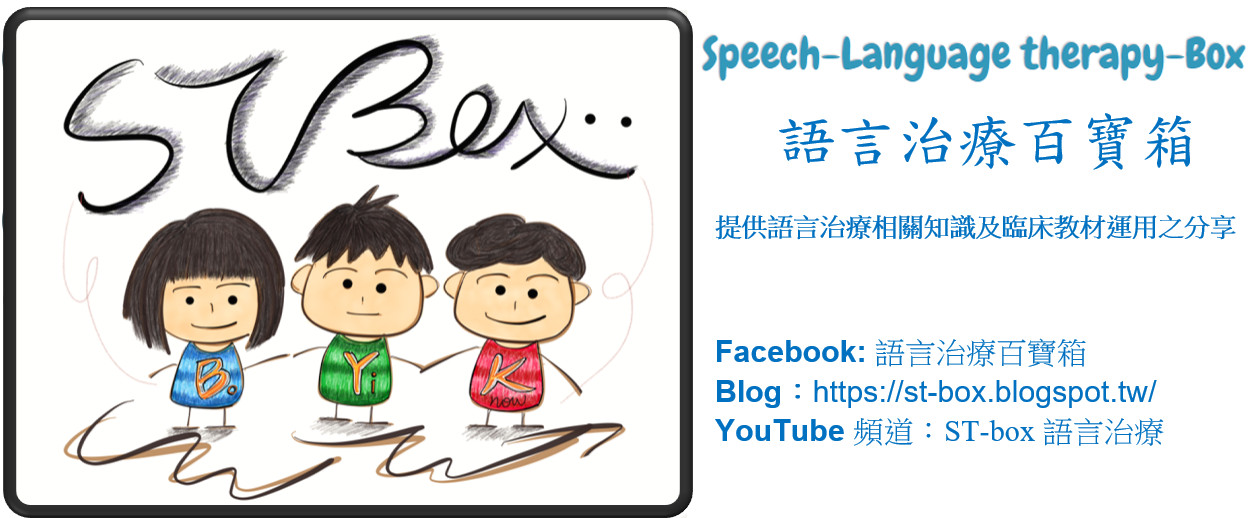Dysphagia in children with infantile cerebral palsy
Otapowicz D1, Sobaniec W, Okurowska-Zawada B, Artemowicz B, Sendrowski K, Kułak W, Boćkowski L, Kuzia-Śmigielska J.
Advances in Medical SciencesVolume 55, Issue 2, 2010, Pages 222-227
目的:對於腦性麻痺之嬰幼兒,吞嚥問題是一顯著的問題,但少被探討。本研究的目的在於分析腦性麻痺嬰幼兒的吞嚥徵兆,包含口腔期及咽部期的吞嚥障礙與嚴重的運動言語障礙。我們也探究吞嚥障礙嚴重性與腦性麻痺的類型、智能發展和癲癇發生率的相關性。
方法:研究對象為67位腦性麻痺嬰幼兒,收集個案史、分析醫學和心理學的資料及吞嚥評估。
結果:在本研究中有41 (61%)的個案有吞嚥障礙的徵兆,多數轉介的原因為口腔期的吞嚥障礙,並伴隨輕至中度的運動言語障礙。有14位個案為口腔期及咽部期的吞嚥障礙,並伴隨嚴重的運動言語障礙。有兩位兒童為最嚴重的咽部期吞嚥障礙。研究顯示吞嚥障礙的嚴重度與ICP的類型、智能發展達顯著相關。
結論:超過50%的腦性麻痺嬰兒童有吞嚥障礙,其一系列的問題,包含口腔期及咽部期吞嚥障礙,主要受到腦性麻痺的類型和重度的智能受損的影響。這些障礙持續從嬰兒時期至幼兒期、青年期,而主要在口腔期的吞嚥能力會有所進步。但運動言語障礙仍是一直伴隨的症狀,尤其是在口腔期與咽部期有吞嚥障礙的個案特別嚴重。因此,針對ICP早期的評估與吞嚥功能的刺激應是其復健重要的一環。
Abstract
PURPOSE:Dysphagia is a significant health problem in children with infantile cerebral palsy (ICP), but not frequently discussed in the literature. The study objective was to analyse dysphagia symptoms in children with a pyramidal form of ICP, including the oral and pharyngeal phases of deglutition and dysarthria severity. We searched for a correlation between dysphagia severity and ICP type, mental development and occurrence of epilepsy.
MATERIAL AND METHODS:A total of 67 children with a pyramidal form of infantile cerebral palsy were studied. Data were obtained based on case history elicited from the mothers, analysis of medical and psychological documentation, and logopaedic examination, including an examination of the action of swallowing.
RESULTS:Dysphagia symptoms were found in 41 (61%) studied children, most frequently referring only to the oral phase (25 children), with concomitant mild and moderate dysarthria. Oral and pharyngeal dysfunctions were observed in 14 children and coexisted with more pronounced dysarthria symptoms. The most severe disorders were mainly found in the pharyngeal phase in 2 children. A statistically significant correlation was noted between the severity of dysphagia symptoms and the ICP type (p<0.044) and mental development (p<0.00002).
CONCLUSIONS:Swallowing dysfunctions occur in the majority of children (>50%) with ICP. More serious disorders involving the oral and pharyngeal phases mainly affect children with tetraplegia and profound mental impairment. These disorders continue from early infancy through childhood and adolescence and improvement has been mainly observed when only the oral phase of swallowing is affected. These are always accompanied by dysarthria symptoms, which are especially severe when dysphagia involves the oral and pharyngeal phases. Early assessment and stimulation of the swallowing function should be a common element in the rehabilitation and care of children with ICP.
INTRODUCTION
正常的吸吮、吞嚥和咀嚼的發展,需要雙唇有適合的技巧以及頰肌和舌頭自主與非自主的動作控制與協調性。腦性麻痺的兒童,在所謂的正常吞嚥動作之相關肌群受到變化性的干擾,在舌頭,軟顎和喉部有異常的張力及動作、感覺異常,導致嗆咳、阻礙吞口水。
雙側上運動神經元受損並伴隨 pseudobulbar and bulbar syndrome的症狀,經常導致吞嚥異常。食物難以形成食團並阻礙液體和固體食物到達食道。而吞嚥動作可以 分成自主動作的口腔期和非自主動作的咽部期與食道期。
MATERIALS AND METHODS
研究共有67位個案腦性麻痺個案(with a pyramidal form of infantile cerebral palsy)年齡為3-17歲。
-腦性麻痺類型:diplegic 42%。 tetraplegic 37%。 hemiplegic 21%
-智能發展:normal 35% ; mental impairment 65% (18% mild, 27% moderate, 20% severe or profound)
與母親訪談了解腦性麻痺兒童早期的吞嚥問題,收集醫學診斷、心理評估資料,由語言治療師評估個案言語障礙及吞嚥障礙情形。
RESULTS
研究中有69%的照顧者表示腦性麻痺的孩子有吞嚥相關的問題,包含:吸吮不佳,咀嚼不佳,必須進食混合質地的食物,進食時間過長,無法操弄嘴巴裡的食物,食物從嘴巴掉出,堆積在舌頭下面,大量的口水流出。其中有18位兒童有嗆咳、咳嗽和嘔吐反射過強。
吞嚥評估顯示有41位有吞嚥問題:
其中25位兒童有口腔期吞嚥問題,在說話時有過多的口水,進食時間過長,雙唇和舌頭動作的功能受損。14位兒童,有較嚴重的吞嚥問題,主要在口腔期及咽部期,舌頭較平坦,臉部歪曲,吞嚥時有較大的聲音,流口水,難以咀嚼及移動食物,在吞嚥液體或固體時有時會嗆咳,在雙唇、舌頭和顎的動作有更嚴重的功能受損,口腔過度敏感,顎咽反射增加。另有2位是最嚴重的口咽期吞嚥障礙,難以進食液體和固體食物,吞嚥時雙唇張力高,嗆咳,有時液體流入鼻腔,經常發生吞嚥問題。
在所有於口腔期吞嚥障礙的個案,也伴隨輕度 (12 位)和中度 (13 位) dysarthria 。若是在咽部期有吞嚥問題其dysarthria則更嚴重。
統計資料分析:
(1)Icp的類型和吞嚥障礙的嚴重程度達顯著的相關
tetraplegic:有較多口咽期吞嚥障礙。
diplegic :也有口咽期吞嚥障礙。
hemiplegic :只有口腔期吞嚥障礙。
(2)吞嚥障礙的嚴重度與智能發展達顯著的相關:
多數有嚴重的吞嚥障礙問題的個案,同時也伴隨重度或極重度的智能障礙。
(3)吞嚥的嚴重度與癲癇無顯著相關。
DISCUSSION
吞嚥問題從早期到青少年期持續存在,即使是流口水的問題也是需要被重視的,在觀感上也是重要的。相關研究指出腦性麻痺者經常有餵食問題、言語問題及腸胃相關的問題。
許多本研究中家長報告顯示,兒童在口腔期的功能是有些進步,而這些兒童主要的吞嚥問題為雙唇和舌頭的動作控制不佳。而有咽部期吞嚥障礙之腦性麻痺者,仍多持續該問題,尤其在嚴重的個案身上(通常是tetraplegic 類型且有嚴重的障礙受損之CP)。
CONCLUSIONS
超過50%以上的腦性麻痺兒童會有吞嚥障礙的問題,發展的成熟並沒有因此而降低其吞嚥問題,這些問題很多仍從幼兒持續到青少年時期。較有改善的是在口腔期的吞嚥障礙情形。早期的吞嚥評估及介入應為腦性麻痺兒童的照護及復健的要素之一。


沒有留言:
張貼留言